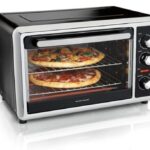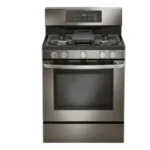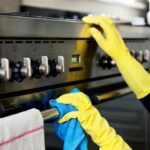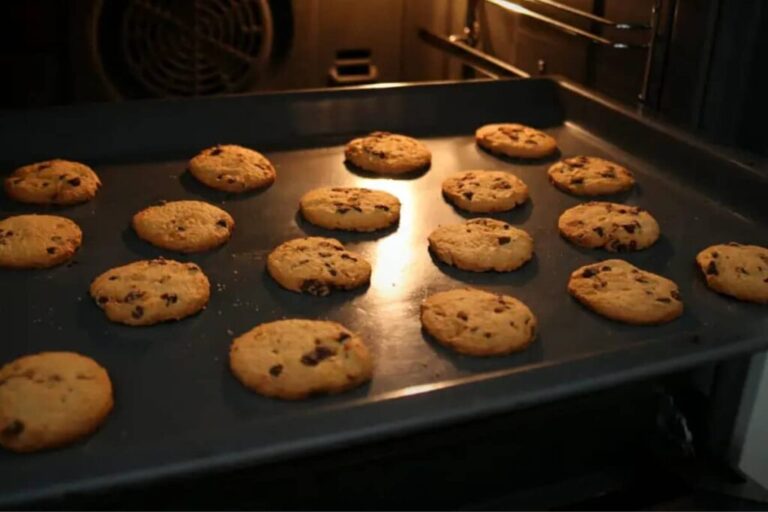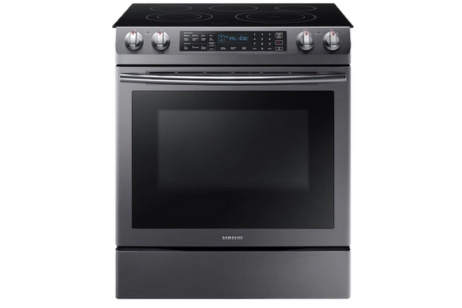Does your home oven need some care and attention? It’s important to take good care of your oven to ensure it lasts long and performs at its best. Whether you’re an experienced chef or a casual home cook, our Oven Maintenance Checklist has 26 easy-to-follow tips to help you keep your oven in great shape.
We cover everything from basic cleaning techniques to essential maintenance practices. To ensure your oven remains a reliable partner in your cooking adventures.
Join us on this informative journey as we explore 26 powerful tips for running your home oven smoothly. This article aims to provide you with valuable details on cleaning tricks and preventive measures. Empowering you to take control of your oven’s maintenance.
Table of Contents
ToggleBenefits of Oven Maintenance Checklist
Implementing an Oven Maintenance Checklist offers numerous benefits to your home oven’s longevity and optimal performance. Let’s explore these benefits:
- Enhanced safety during cooking.
- Improved cooking efficiency and consistent results.
- Extended lifespan of your oven, avoiding costly repairs or replacements.
- Energy savings through optimal functioning.
- Early detection of potential issues through preventive measures.
- Cost savings by minimizing major breakdowns or emergencies.
- Better cooking performance with even heat distribution.
- Maintaining hygiene and cleanliness for a healthier cooking environment.
How to Clean Burnt Sugar from Oven: Learn 11 Easy Methods
Safety Precautions Checklist
Safety during oven maintenance is crucial to prevent accidents and ensure a smooth process. Here are some essential safety precautions to keep in mind:
Tip 1: Turning off and unplug the oven
Before you begin any maintenance tasks, the first and most crucial step is to turn off and unplug your oven. This ensures your safety by eliminating the risk of electric shock. Take a moment to locate the power source and switch off the oven. Then, unplug it from the wall socket to ensure complete disconnection from the electrical supply.
Tip 2: Wearing protective gear
It’s important to prioritize your safety when handling oven maintenance tasks. Wear appropriate protective gear, such as oven mitts or gloves, to shield your hands from potential burns or injuries. Additionally, consider wearing safety goggles or glasses to protect your eyes from debris or cleaning solutions that may splash during the process.
Tip 3: Avoiding harsh chemicals
While cleaning your oven, reaching for strong and abrasive chemicals to tackle stubborn stains is tempting. However, avoiding harsh chemicals is essential as they can damage the oven’s surfaces and pose health hazards. Instead, opt for milder, eco-friendly cleaning solutions or DIY alternatives, which are equally effective and safer for you and your oven.
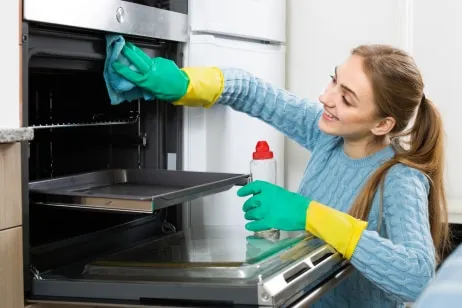
Exterior Cleaning Checklist
When maintaining your oven, paying attention to the exterior is as important as the interior. Let’s delve into three essential tips to keep your oven clean and fresh.
Tip 4: Removing crumbs and debris
Start by removing any crumbs or debris accumulated on or around your oven. Use a soft, dry cloth or a handheld vacuum cleaner to remove the particles gently. Be thorough, especially around the oven’s edges and crevices, as crumbs can build up over time and affect the overall performance of your oven.
Tip 5: Wiping down control panels and knobs
To ensure smooth operation and prevent sticky residue from building up, regularly wipe down your oven’s control panels and knobs. Clean the surfaces by dampening a cloth with mild soapy water, wringing it dry, and wiping them lightly. Remember to dry them thoroughly afterward to avoid water damage.
Tip 6: Cleaning the oven door and handle
The oven door and handle can accumulate grease and grime, diminishing the visual appeal of your appliance. Use a non-abrasive cleaner or vinegar and water to wipe away any stains. Pay attention to the glass door, as fingerprints and smudges can be easily noticeable. Gently scrub the surface and dry it with a lint-free cloth for a sparkling finish.
Learn How to Clean a Pizza Oven Like a Pro!
Interior Cleaning Checklist
Follow these four tips to keep your oven cavity sparkling and free from stubborn stains.
Tip 7: Removing oven racks and soaking them
Start by removing the oven racks. Gently pull them out and set them aside. Fill your sink or a large basin with warm water and mild dish soap. Let the racks soak for a while to loosen any grime or residue.
Tip 8: Cleaning the oven cavity
Now, turn your attention to the oven cavity. Warm and dampen a soft cloth or sponge with warm, soapy water. Begin wiping down the interior surfaces, paying extra attention to areas with food splatters or grease buildup. Use gentle, circular motions to remove any dirt.
Tip 9: Removing burnt-on food and stains
If you encounter burnt-on food or stubborn stains, don’t worry. Combine baking soda and water to form a thick paste. Put the paste on the spots that hurt and let it sit for a few minutes. Then, use a non-abrasive scrub brush or sponge to scrub away the residue gently. Rinse thoroughly with clean water.
Tip 10: Cleaning the oven fan and vents
Lastly, don’t forget to clean the oven fan and vents. These areas can accumulate dust and debris over time, affecting the oven’s performance. Soft brushes or vacuum brush attachments remove dust and debris. Be gentle to avoid damaging the fan or vents.
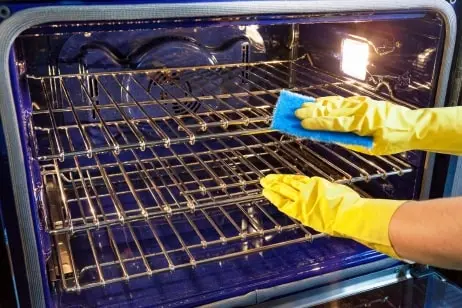
Oven Accessories Checklist
Maintaining oven accessories is crucial for the smooth operation of your oven. Here are some valuable tips for keeping your oven racks, baking stones, and oven light bulbs in shape.
Tip 11: Cleaning and maintaining oven racks
Cleaning oven racks is a vital part of the oven maintenance checklist. Remove them from the oven and soak them in warm, soapy water to keep them in top shape. Scrub away any grime or residue with a soft sponge or cloth. Rinse them thoroughly and let them dry before placing them back in the oven. Regular cleaning will prevent grime buildup and ensure even heat distribution during cooking.
Tip 12: Take care of baking stones or pizza stones
If you enjoy baking or making pizzas, taking care of your baking stones or pizza stones is essential. After each use, allow them to cool completely, then remove any stuck-on food with a spatula or brush. Avoid using soap or harsh chemicals, as they can seep into the stone and affect the flavor of your future dishes.
Instead, wipe the stone with a damp cloth and let it air dry. Baking soda may be sprinkled on the stone, scrubbed gently, and then rinsed off thoroughly to remove persistent stains. This will help maintain the integrity of the rock and ensure optimal cooking results.
Tip 13: Cleaning and replacing oven light bulbs
A dim or non-functional oven light can make it challenging to monitor your cooking progress. First, to clean the oven light bulb, ensure the oven is turned off and cool. Gently remove the bulb cover, if applicable, and unscrew the bulb.
Clean the bulb with a soft cloth or tissue, ensuring it’s free from grease or residue. If the bulb is damaged or burnt out, replace it with a new one of the same wattage. This simple maintenance step will provide proper lighting inside the oven, making your cooking experience safer and more convenient.
Oven Functionality Checklist
Ensuring the functionality of your oven is crucial for achieving perfect cooking results. Here are three essential tips to keep your oven in top shape:
Tip 14: Testing the oven temperature
To ensure accurate cooking, it’s essential to test your oven’s temperature regularly. Here’s how:
- Preheat your oven to a specific temperature, such as 350°F (175°C).
- Check the oven’s actual temperature using a thermometer.
- Place the thermometer in the center of the oven and wait for a few minutes.
- Compare the reading on the thermometer with the set temperature.
Tip 15: Calibrating the oven, if Necessary
If your oven consistently shows a temperature variance, which may require calibration. Follow these simple steps:
- Refer to your oven’s manual to locate the calibration feature.
- To calibrate, heat the oven to the required degree.
- Check the correctness of the temperature using a thermometer placed in the oven.
- Adjust the oven’s calibration settings as per the manufacturer’s instructions.
- Test the oven temperature again to ensure accurate readings.
Tip 16: Checking the door seal for leaks
A faulty door seal can lead to heat loss and uneven cooking. Follow these steps to check the seal:
- Close the oven door and inspect the gasket that runs around the door perimeter.
- Look for any visible signs of wear, cracks, or deformities.
- Ensure that the seal is clean and free from food debris.
- Close the door firmly and check for any gaps or loose areas.
10 Reasons Why Your Oven Is Not Working and How to Fix?
Maintenance Tips Checklist
If you follow some basic guidelines, you can ensure its longevity and keep it in excellent condition. Here are four essential maintenance tips that you should keep in mind.
Tip 17: Regularly cleaning spills and stains
Do not delay in removing stains and spills. Wipe away any food particles or liquids that may have dripped onto the oven surfaces. Scrub carefully with baking soda, water, or a light detergent to remove stubborn spots. Regular cleaning prevents residue buildup and keeps your oven looking clean and fresh.
Tip 18: Avoiding using harsh cleaning products
When cleaning your oven, avoid using harsh chemicals or abrasive cleaning agents. These can damage the oven’s surfaces and affect its performance. Instead, opt for mild, non-abrasive cleaners that are safe for your oven’s interior and exterior.
Tip 19: Checking for any signs of damage or malfunction
Regularly inspect your oven for any signs of damage or malfunction. Look for cracks, loose knobs, or malfunctioning buttons. Get in touch with a repairman if you find any problems. Addressing problems promptly can prevent further damage and ensure your oven functions properly.
Tip 20: Maintaining proper ventilation
Proper ventilation is crucial for your oven’s performance and safety. Ensure the vents and exhaust system are clean and unobstructed. Good airflow prevents overheating and helps maintain consistent cooking temperatures.
Troubleshooting Common Issues Checklist
Is your oven giving you a hard time? Don’t worry; we’ve solved three common oven issues. Let’s dive right in!
Tip 21: Oven not heating properly
- Check the power supply and ensure the oven is plugged in.
- Inspect heating elements for damage or signs of malfunction.
- Recalibrate temperature settings if necessary.
- Clean the oven interior to remove debris that may affect heat distribution.
Tip 22: Uneven heating
- Remove any obstructions or blockages from the oven’s vents.
- Verify that the oven racks are properly positioned for adequate airflow.
- Rotate dishes halfway through cooking to promote even heat distribution.
- Consult a professional if the heating elements or thermostat require inspection.
Tip 23: Oven door not closing properly
- Examine the door seal for damage or wear.
- Clean the seal and ensure it aligns properly with the door frame.
- Adjust or replace hinges if needed.
- Seek assistance from a technician for expert help if necessary.
Professional Maintenance Checklist
When it comes to maintaining your home oven, there are times when you may need to turn to the expertise of professionals.
Tip 24: When to seek professional help
- Notice persistent issues like inconsistent heating, strange noises, or frequent breakdowns? Call in the experts.
- Professional oven technicians have the knowledge and skills to diagnose and fix complex problems effectively.
Tip 25: Importance of regular servicing
- Regular servicing ensures optimal performance and longevity of your oven.
- Thorough cleaning, component inspection, and temperature control calibration are part of professional servicing.
- Catch potential problems early and prevent costly repairs by scheduling regular maintenance.
Tip 26: Finding a reliable oven repair service
- Try to choose a business that has been around for a while and has a history of satisfied customers and expert servicemen.
- Seek recommendations from friends or family who had successful experiences with oven repair services.
- A reliable repair service offers prompt response times, transparent pricing, and warranties on their workmanship.
Remember
- Professional maintenance is essential for the longevity and smooth operation of your oven.
- Don’t hesitate to seek professional help when needed.
- Prioritize regular servicing to catch problems early and avoid costly repairs.
- Choose a reputable repair service to ensure your oven is in capable hands.
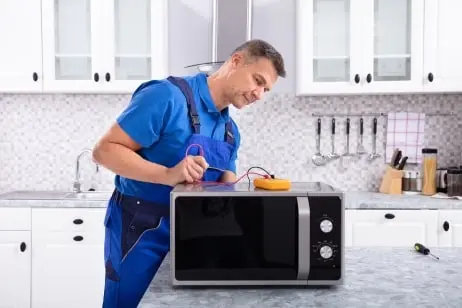
Conclusion
In conclusion, prioritizing oven maintenance is essential for a safe and efficient cooking experience. By following the 26 powerful tips outlined in our Oven Maintenance Checklist, you can ensure that your home oven remains in top-notch condition for years.
By implementing these maintenance practices, you can also enjoy the benefits of consistent heating. A well-maintained oven distributes heat evenly, resulting in perfectly cooked meals every time. Plus, a properly maintained oven consumes less energy, helping you save on utility bills while reducing your environmental footprint.
So, take charge of your oven’s maintenance today. Follow our checklist and make it a regular part of your kitchen routine. By doing so, you’ll ensure a safe and efficient cooking experience, unleash the full potential of your oven, and enjoy many delicious meals for years to come.


